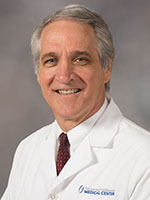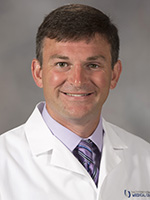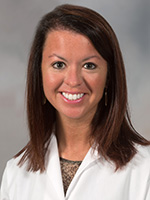College students concede coping issues, embrace counseling services
Published on Tuesday, August 29, 2017
By: Gary Pettus
NOTE: This article originally appeared in the September 2017 issue of CONSULT, UMMC's monthly electronic newsletter. To have CONSULT, and more stories like this, delivered directly to your inbox, click here to subscribe.
She was no different from many other students in college or professional school – anxious about her studies, doubting her career choice.
 Patel
PatelAvni Patel, now a third-year medical student at the University of Mississippi Medical Center, had never been in counseling, didn’t believe she needed it, knew she had no major mental health problems – but went anyway.
“It was the best decision I ever made,” said Patel, 24, of Flowood. “It’s made me happier. I believe it has made me a better student and is going to make me a better doctor.”
Patel is one of a number of college-age adults who have explored mental health services across the country at a rate that is outpacing an enrollment spike – 30 percent, compared to only 5 percent, respectively, between 2010 and 2016, according to the Center for Collegiate Mental Health’s (CCMH) 2016 Annual Report.
And no wonder: College students, particularly brand-new ones, find themselves in situations they’ve never faced before, which can be a dilemma as well for parents who worry about and want to help them.
 Merideth
MeridethBetween ages 18 and 24, the brain is still developing, which can lead to “challenges in judgment and impulsivity,” said Dr. Philip Merideth, professor of psychiatry and co-director of the Student Counseling and Wellness Center.
 Burgess
BurgessThese relatively brash students also face a lot of change, a lot of self-discovery, more freedom and less structure than ever before, and the need for an identity separate from their parents’, said Dr. Danny Burgess, associate professor of psychiatry and the center’s other co-director.
“And then you combine that with the stress of school,” Burgess said. “They make up a unique, vulnerable population.”
Although it is not the case with Patel, their vulnerability can lead students to be more reluctant to reveal their concerns to their parents, in many cases.
Close to half of college-age adults have a diagnosable psychiatric disorder, the CCMH report stated. “That’s higher than for the general population, for which it’s more like 10 to 20 percent,” Burgess said.
Beyond the CCMH report, the American College Health Association disclosed in its Spring 2014 National College Health Assessment II that more than one in three college students stated they had been so depressed within the past 12 months that “it was difficult to function.”
 Lea
LeaAttention-deficit/hyperactivity disorder looms larger, said Rosanna Lea, a UMMC nurse practitioner in psychiatry. “ADHD is more prevalent than depression,” she said.
 Withane
WithaneADHD may have been diagnosable before college, but the student may have not sought help until those symptoms were hardened under college classroom pressures, said Dr. Nisha Withane, a UMMC child and adolescent psychiatry fellow.
“And the resources may not have been available to them before they came here,” Withane said.
At UMMC, those resources include LifeSynch, a call-in help line for students and employees; the first three sessions with a licensed counselor or psychologist are free, but costs may apply afterward.
“It takes more than three sessions among the students I’ve seen,” Burgess said.
Many turn to the Student Counseling and Wellness Center, which opened a year ago and averages about 50 visits per month, a figure Burgess expects to only go up via more word-of-mouth.
“One thing I like about being at a Medical Center is that, for a lot of students, this is the first time they have become involved with therapy – and why not? It’s free,” Burgess said.
“It’s a chance to show them that it’s OK to deal with a psychotherapist, to show them that they’re normal; they’re just dealing with abnormal circumstances.”
This was the case with Patel, who meets with Burgess weekly.
“I was very stressed with school, I was really hard on myself with exams, I was questioning whether I would make a good doctor,” Patel said. “But I was very skeptical about going to the Wellness Center.
“I had never had counseling before. I thought, ‘Why should I see someone just to talk about my everyday problems?’ I thought it would be a waste of Dr. Burgess’ time. But two of my friends recommended it.”
It took three meetings with Burgess before Patel was sold.
“It was amazing. It changed a lot of what I think about mental health,” she said. “Talking to someone who will listen to you will help you keep things in perspective.
“You realize it’s not the end of the world, whatever comes your way.”
College-age angst isn’t new, but some enablers are, Merideth said.
“This generation is dealing with peer pressure from social media,” he said. “People are in each other’s business all the time; they get worked up over a flood of comments they wouldn’t have had to deal with in the pre-social media age.”
Burgess said social media tends to downplay the possible consequences of sexualization and sexual acts. With certain apps, “sex becomes more casual and convenient than it needs to be,” he said. Sexual abuse or assault becomes a risk.
“Then afterward, there are feelings of guilt and shame; it changes a person – how they see themselves and how they see others.”
Substance abuse, eating disorders and thoughts of suicide may follow, as they might with any emotional or physical trauma. Suicide is the second most common cause of death among this age group, the CCMH points out.
Since most college students are legally adults, counselors cannot discuss their problems with anyone else, including their parents, without a signed release.
“Otherwise, when harm to a student or to someone else is possible, we can reach out,” Withane said, “but I’m still limited in the information I can give.”
Since no insurance is needed – the services at the Student Counseling and Wellness Center are, after all, free – no “explanation of benefits” comes the parents’ way.
In this context, the experts offered the following advice to parents:
• Look for changes in a student’s routines or behavior (sleep habits, appetite, etc.).
• If the student has frequent contact with a professor, mentor or other person at the school, let that person know about a potential problem.
• Know the mental health resources available on the student’s campus or in the community and point him or her in the right direction.
• If a student already has been in counseling within the last year, college is not the time to stop it. “This is fertile ground for an issue to pop up again,” Burgess said. On that note, suggest that the student send his or her patient records to the new mental health service. “It ensures continuity,” Lea said.
• Speak with the student about signing a release, but in the end, “that’s a family decision,” Merideth said.
• “Be a supportive, but not a smothering, parent,” Merideth said. “Let them know you are there for them.”
To her fellow students, Patel offers this: “If you have issues, the Wellness Center is a great place go; but if you don’t have issues and you just want to work on yourself, it’s still a great place to go. I believe we’re very lucky to have this.
“It’s something I look forward to every week. Just talking about your everyday small, or big, problems makes you grow. You’d be surprised.”